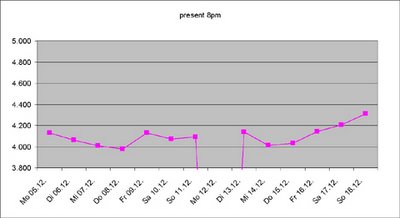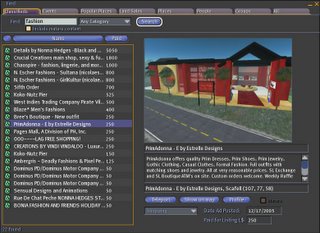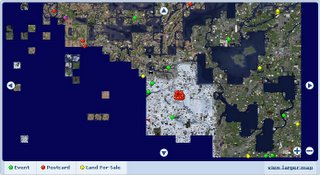Cold facts The daily trading volume at the LindeX, which did not show much in the way of an upside trend in the last two weeks rose to new heights at the beginning of the weekend. More than 4.2 Million L$ changed hands on Thursday and Friday. Saturday still showed a volume of 3,9 Million. This was not driven by sellers cashing out for RL presents. Otherwise the exchange rate would have fallen because of selling pressur. But the exchange rate seems to really have reached a more or less stable plateau at 265L$/US$, up some 4% from the typical 252L$ - 255L$/US$ in November.
The daily trading volume at the LindeX, which did not show much in the way of an upside trend in the last two weeks rose to new heights at the beginning of the weekend. More than 4.2 Million L$ changed hands on Thursday and Friday. Saturday still showed a volume of 3,9 Million. This was not driven by sellers cashing out for RL presents. Otherwise the exchange rate would have fallen because of selling pressur. But the exchange rate seems to really have reached a more or less stable plateau at 265L$/US$, up some 4% from the typical 252L$ - 255L$/US$ in November.
Resident activity was up, too. After a phase of stagnation in the last weeks, the number of concurrent users which were online at around 8pm SL time is again on the rise. It is growing not nearly as fast as the number of residents. This grew from some 95,000 on Monday to more than 98,000 on Sunday. 

I am expecting Mr. or Ms. One-Hundred-Thousand onThursday. While business oriented residents often are dissapointed by the relativly meager volume of additional sales all these Basic Accounts generate, the 100,000th resident surely will be an important milestone in the history of SL. (And I hope LL will use this effectively for PR purposes at the beginning of the new year.)
That was the raw data (and a little interpretation). But now, back to "current events and happenings in the SL economy". Last weeks most interesting events with some importance to the SL economy were (in my own completely subjective opinion):
- P2P teleporting is here!
- Classifieds revamped
- A new open API for the Second Life Map
- Griefer attacks and the FBI
- Developer incentive phased out
P2P is finally here to stay
With the advent of version 1.8 Point-to-Point teleportation has finally arrived in Second Life. Personally I would have preferred it had 1.8 brought an end to the texture loading and cache problems, but it sure is convenient. It remains to be seen, what consequences it will have for the SL society and economy. Robin has already published some early data about the distribution of sales volume between telehub sims, non-telehub sims and private islands. But it is way to early to interpret anything into this data. I hope she will have at least two follow-ups in the next few weeks so we can really see any trends.
I am expecting some quite significant changes with regard to shop location, mall culture (or lack thereof), buying habits etc. over the course of the next 2 - 3 months. As I already said last week, I would be very wary to invest much in simple malls with many small booths currently. Themed malls MIGHT still be an interesting concept, even though they will face some hardship from the outphasing of the developer incentive.
BTW: I still have not heard much of the "compensation" for owners of telehub land which was announced (for consideration) by Linden Lab and heavily discussed on the forums.
Classifieds revamped
There is not much more to like with the classifieds in my opinion. It is a horribly limited and severely flawed solution for advertising in SL. It is not much more than a bastard of classifieds, yellow pages and a kind of public product catalogue.
The new classifieds just highlight a gaping hole in the current SL economy: there is simply no way for effective inworld advertising. And it is a “gaping” hole! A mostly free-market style capitalistic economy simply needs advertising. The current solutions for this need are pathetic: signs and posters and a competition for the most eye-catching builds with many results of questionable aesthetics. MetaAdverse? This is a nice and technically sweet solution (cudos to Rathe). But posters are definitely not a perfect form of advertising in the SL we live in. The texture loading problems of 1.7 only emphasize this.
The new Map-API
One first step in a similar direction is the new map-API that Bub Linden introduced last week. This API allows it anyone with a little knowledge of HTML and JavaScript to use the Second Life global map much in the same way as it is shown on the current SL homepage. 
Why do I think this is significant for the economy? Because an API like this allow businesses to better integrate web based services much better with SL. It is easy now, for example, for a Land Baron to set up a catalogue of available parcels and show its location on the map. Or take a part of the map and overlay it with positions of shops, other players (in a game), etc. Snapzilla could now display the position where a snapshot is taken easily in its interface and mark the locations of other snapshots nearby. I am not sure what other applications of this simple API residents will develop. But I am sure there will be a lot. Combine this with another API for accessing the internal land-sales database or one in which you can register product offerings (like in the flawed classifieds) and pipe that back into SL via HTML-on-a-prim and some cool things will happen!
This is definitely a step in the right direction!
Griefer attacks and the FBI
The Herald published a story this week citing Philip Linden that Linden Lab has given the data of one (or more) griefer(s) responsible for the latest grid-wide attack to the FBI. This has not been denied it was widely commentated on the web (in many MMOG focused weblogs and even on C-Net). LL has earned a lot of criticism which usually went in the way of “Hey, it’s a game, man! The FBI has real world criminals (terrorists) to investigate!” or “Linden Lab is responsible itself for those attack. If the closed or crippled LSL …” or “Anything that is possible in the game is legal by definition!” Clickable Culture has a nice collections of comments on the issue and links to other weblogs with more.
Of course, trying to involve RL law enforcement in inworld problems can have some nasty consequences (the much feared “regulation”). But this is another question.
The end of the Developer Incentives
OK, I am cheating. The announcement of the imminent death of the developer incentive (the monthly US$ payment for the 5% of landowners with the most traffic on their land) was not last week. It happened this Monday. But it is much to important to wait another week.
I have to admit, that I was surprised. Even though I – and many other residents - expected the DI to be killed (see my post from two weeks ago), I did not expect this to happen so fast. But it was foreseeable. And it wasn’t the camping chair phenomenon that brought the DI down. Camping chairs just put the spotlight on the fact that dwell (traffic) is not a very good measurement if the activities of a resident do help Linden Lab in achieving its business goals. And – let’s face it – that is and has always been the purpose of the developer incentive.
This will be hard for many businesses; obviously for anyone in the entertainment industry, but hard for others, too. Many shop- or mall-owner counted on the DI as an additional source of income and included it in their business model. All of these models will now have to be recalculated. Or maybe they already had to be. Camping chairs and similar systems made sure (or would make sure in the next one or two months) that not many sites not offering them get much in the way of developer incentive.
In the long run this will be good for the SL economy, IMHO. "Developers" now have to focus on offerings that really make Second Life a more interesting place to be. If these offerings are interesting, entertaining, challenging enough more people might be willing to pay for it. People are willing to pay for entertainment. The offer just has to be "right". Just have a look at iTunes, which came up at a time where not many believed in "selling" music over the internet. Apple showed them differently ...
Of course, setting up an offering for which people are willing to pay, is substantially more challenging then placing some camping chairs near a dance club. But who said that success in business has to be easy?
No comments:
Post a Comment